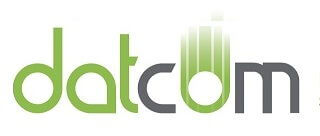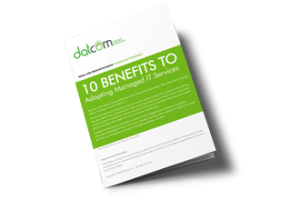This week, as promised, we will be taking a closer look at Data Processing Automation (DPA)!
It’s amazing how simple a revolutionary technology can be. The light bulb. The automobile. These inventions had a huge impact on the way people live. But what happens when technology gets out of sync with human life? Some people run back to minimalism, and others press on toward a breakthrough. DPA is that breakthrough!
The History of Your Keyboard
Are you sitting in front of a computer right now? Or maybe you’re on your phone or tablet. If you were to look at your keyboard, you’ll notice that it has a standard QWERTY layout (if you’re using an English keyboard, that is).
Do you know why the QWERTY layout is standard?
It’s because the old mechanical typewriters of the late 1800s had moving parts that were too slow to keep up with maximum human typing speeds. The mechanical arms of the typewriter would get jammed up if a typist worked too quickly. The designers of these typewriters understood that if they rearranged the letters, it would slow down the typing process and prevent the machine from jamming.

That’s not a problem in the digital era, and yet the keyboard remains unchanged because most people would not like to relearn typing on a different layout. Here we are in 2022, and an artificial barrier erected in the 19th century is keeping people from maximum productivity.
The same can be said for how we use computers to conduct business, today. New technologies such as speech recognition to make the typing process faster, and Data Processing Automation is here to revolutionize the way we use technology to complete business processes.
What You Need to Know about DPA
Data Processing Automation is an important technology that enhances life by empowering businesses to make better use of their computer technology and their human resources. DPA is something that most businesses need to know about, but few do. DPA is custom software to automate repetitive tasks normally performed by people.
The result?
- As a business owner, you get 1/3rd of your business tasks accomplished without human help. You can scale your business with fewer employees and enjoy greater profits and draw the best employees.
- If you’re an employee, you don’t have to spend your days doing repetitive, boring work at a computer.
- If you’re a customer, you get faster responses from vendors and service providers, better customer service, and greater product availability.
Every day, workers sit behind computers and do “work” that isn’t necessary. Not only that, but they also often make mistakes that cost companies a lot of money. It simply isn’t high-value work anymore because software can do it faster, better, and with much less downtime. DPA is a technology that respects human ingenuity. It can reduce workplace boredom, increase productivity, and bring vibrance and vitality to your organizational culture.

It’s software that enables humans to live well.
It’s nice. It’s a luxury. But it’s also profitable. And how often are luxuries profitable?
DPA implementation can take a few weeks to get rolling but the benefit is years of increased profit-potential, and that’s an absolute necessity right now.
The Myth of Human Replacement
Automation experts everywhere cannot stress this enough: People are a premium business resource. The purpose of business automation isn’t to lop off heads. No one wants to lay people off. It’s stressful and costly.

And it’s no question that human workers are more valuable to your business than machines and technology. But most human resources are not being utilized to their full potential. By automating data entry, for example, you can leave your people open to solving more complex problems and operating where your customers want to talk to a real human being.
Accuracy is extremely important when you need to meet certain standards of compliance. Businesses need to be fast and accurate when it comes to processing data. Computers are 472 times faster and more accurate than people, but not smarter. Data Processing Automation elevates people because it takes demeaning, repetitive work away so that they can do new work that is more valuable to the business.
Profitability
DPA implementation starts with a few obvious tasks being automated, but there’s a very deep well of possibility here. That’s why DPA is not a turnkey solution. Businesses need to establish a strong relationship with a managed service provider (MSP) who can build up their business infrastructure with DPA.
Generally, by automating 1/3rd of a business’ administrative tasks, and by redeploying workers intelligently, the business can see a profit increase of at least 7-14%. We’ve run the numbers again and again and it always bears out. The profitability for businesses where more workers are using computers is higher than for businesses with a smaller administrative staff.
And the value only increases as you add additional automation to your business. It’s an iterative process and your DPA provider is a profit center, not a cost center in your budget.
The Joy of Seamless Integration
You know how it feels when you find out that a key piece of software has a new integration with another application that you need? With DPA, you can get that across your entire tech stack!
Maybe you’ve seen automation and fancy integrations within newer applications. But DPA works on a whole other level. It works on top of applications, only 472 times faster than a human and doesn’t make careless mistakes. DPA ties all your software together so that applications can “talk to each other” without relying on the software developers. The legacy software you need that doesn’t integrate with anything can be connected to everything else you use with DPA.
How a Business Can Implement DPA
Discovery
It begins with a thorough analysis of your data processing activities. We capture tasks that are repetitive, time-sensitive, require compliance, impact other processes, are standardized, and have the potential for a high return on investment. We laser in on these tasks and create a visual process map of the system. These can be invoicing, sales orders, accounting, data entry, system queries, payroll, and employee on-boarding or termination, just to list a few.
Programming
Next, we research and apply software solutions that can automatically perform these tasks. We look for solutions that are simple and easy to understand. They will also be scalable and flexible so that you can adapt to future growth. We do this with your input and assistance so that processes are carried out correctly. We ensure that programming is keyed to specific performance indicators so that you can know when your goals have been achieved.
Testing
Once the programming solutions are in place, we will test them to ensure that they achieve the desired results. These tools are not intended to be set-in-stone. Monitoring, measurement, and adjustment will ensure that your system remains at peak performance. The costs of this maintenance and upkeep are truly negligible compared with the profits. The definition of efficiency is to spend only that which is necessary for maximum productivity and maintaining your new DPA solutions will be much cheaper than the cost of labor.
Operations
After your DPA solutions have been fully tested, we will enter the operations phase in which you work with the software and reap the benefits that Data Processing Automation provides. The full life cycle of the software will include necessary updates and bug fixes, but you staff will be expert users in no time, able to train new employees in how to use it.
Review
Throughout the life cycle of your DPA solutions, your provider will seek feedback from you to continue enhancing the automation. It’s an iterative process that continues to reap new rewards as your relationship with the provider grows.

What once took hours for a human to perform will only take minutes for the computer, relieving the individual to perform higher valued tasks, become more efficient at their daily work, and reduce stress and errors while reducing work hours. And this leads to excellent operational efficiency which increases profits.



